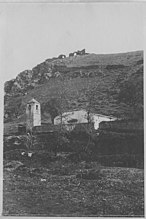| Neo Gynaikokastro Νέο Γυναικόκαστρο | |
|---|---|
| Community | |
 The church photographed by the French Army in June 1916 The church photographed by the French Army in June 1916 | |
  | |
| Coordinates: 40°55′16.47″N 22°44′48.4″E / 40.9212417°N 22.746778°E / 40.9212417; 22.746778 | |
| Country | Greece |
| Administrative region | Central Macedonia |
| Regional unit | Kilkis |
| Municipality | Kilkis (municipality) |
| Municipal unit | Pikrolimni |
| Elevation | 75 m (246 ft) |
| Population | |
| • Community | 751 |
| Time zone | UTC+2 (EET) |
| • Summer (DST) | UTC+3 (EEST) |
| Postal code | 612 00 |
| Area code(s) | 23430 |
| Vehicle registration | KI |
Neo Gynaikokastro (Greek: Νέο Γυναικόκαστρο, old name: Avret Hişar) is a village in the Kilkis region of Greece. It is situated in the municipal unit of Pikrolimni, in the Kilkis municipality, within the Kilkis region of Central Macedonia.
Geography
The terrain around Neo Gynaikokastro is a bit hilly. The highest point in the vicinity is 188 metres above sea level, 1.6 km north of Neo Gynaikokastro. Around Neo Gynaikokastro it is quite sparsely populated, with 42 inhabitants per square kilometre. The nearest major community is Kilkis, 13.3 km northeast of Neo Gynaikokastro. The area around Neo Gynaikokastro consists mostly of agricultural land.
The climate in the area is humid and subtropical. The average annual temperature in the neighbourhood is 17 °C. The warmest month is August, when the average temperature is 30 °C, and the coldest is December, with 3 °C. Average annual rainfall is 844 millimetres. The wettest month is February, with an average of 116 mm of precipitation, and the driest is August, with 21 mm of precipitation.
History
Byzantine Era
The wider area of Gynaikokastro was initially part of ancient Mygdonia and then, during the reign of Alcetas I of Macedon (658-540) and Amyntas I of Macedon (540-498). In 1334 a castle was built in the area by Andronikos III Palaiologos to protect, mainly from the Serbs, Thessaloniki and to protect the crop of the Macedonian plain.
Ottoman Rule
Around 1383, it was occupied by the Ottoman Turks under the leadership of Gazi Evrenos Bey, hence the old name of the village was Avret Hisar or Avret Isar. During the years of Ottoman rule there was the kaza of Avret Hişar that belonged to the Salonica Vilayet.
Greek Rule
The village was transferred to Greek sovereignty as a result of the Second Balkan War. This area of the Macedonian front was the scene of fighting between the Bulgarians and the Entente forces dominated by the Armée d'Orient (1915–1919). A number of photos from this time have survived.
Its current inhabitants are descended from Greek refugees who came from the "Tsataltza" province of Istanbul and the "Artohan" region of the Caucasus. In 1926, refugees from Eastern Thrace settled, namely from the villages of Oklali, Lazarkioi, Ambarli and Akala in the area of Metron (Tsataltzas), near Lake Derko and the village was renamed Nea Dimitra. In 1928 the name was corrected to Neo Gynaikokastro. In 1928 the village was entirely populated with resettled refugees, comprising 608 people in total within 178 families.
According to the Kallikratis plan, the village, along with Vakoufi, Kokartza and Kato Apostoloi, constitute the local community of Neo Gynaikokastro, which belongs to the municipal unit of Pikrolimni of the municipality of Kilkis. According to the 2021 census the community has a population of 751 inhabitants.
In 1994, the hill northwest of the village was declared a protected archaeological site.
Notes
Notes
- Calculated from the variance in all elevation data (DEM 3 ") from Viewfinder Panoramas, within 10 km radius. sv:Lsjbot-algoritmnot
- Calculated from height data (DEM 3 ") from Viewfinder Panoramas.
References
- ^ "Αποτελέσματα Απογραφής Πληθυσμού - Κατοικιών 2021, Μόνιμος Πληθυσμός κατά οικισμό" [Results of the 2021 Population - Housing Census, Permanent population by settlement] (in Greek). Hellenic Statistical Authority. 29 March 2024.
- ^ "Μετονομασίες των Οικισμών της Ελλάδας" [Renames of the Settlements of Greece] (in Greek). Πανδέκτης: Name Changes of Settlements in Greece. Retrieved 19 January 2019.
Avret Issar - Gynaikokastron
- ^ "Viewfinder Panoramas Digital elevation Model". 2015-06-21.
- "NASA Earth Observations: Population Density". NASA/SEDAC. Retrieved 30 January 2016.
- "NASA Earth Observations: Land Cover Classification". NASA/MODIS. Retrieved 30 January 2016.
- Peel, M C; Finlayson, B L. "Updated world map of the Köppen-Geiger climate classification". Hydrology and Earth System Sciences. 11: 1633–1644. doi:10.5194/hess-11-1633-2007. Retrieved 30 January 2016.
- "NASA Earth Observations Data Set Index". NASA. Retrieved 30 January 2016.
- "NASA Earth Observations: Rainfall (1 month - TRMM)". NASA/Tropical Rainfall Monitoring Mission. Retrieved 30 January 2016.
- Παπαθανασίου, Μανώλης. "Γυναικόκαστρο" [Gynaikokastro]. Καστρολόγος (in Greek). Retrieved 2019-01-19.
- "Wikimedia Commons results when "secteur de Avret Hissar" is searched".
- "Γυμνάσιο Νέου Γυναικοκάστρου, Η ιστορία του χωριού" [Neo Gynaikokastro High School, The history of the village] (in Greek). Retrieved 2015-06-06.
- "Λιθοξόου, Δημήτρης. Μετονομασίες των οικισμών της Μακεδονίας 1919 - 1971" [LITHOXOU, Dimitris. Renamed settlements of Macedonia 1919 - 1971] (in Greek). Archived from the original on 2012-06-30. Retrieved 2012-06-30.
- "Κατάλογος των προσφυγικών συνοικισμών της Μακεδονίας σύμφωνα με τα στοιχεία της Επιτροπής Αποκαταστάσεως Προσφύγων (ΕΑΠ) έτος 1928" [List of refugee settlements in Macedonia according to the data of the Committee for the Rehabilitation of Refugees (EAP) year 1928] (in Greek). Archived from the original on 2012-06-30. Retrieved 2012-06-30.
- "ΔΙΑΡΚΗΣ ΚΑΤΑΛΟΓΟΣ ΚΗΡΥΓΜΕΝΩΝ ΑΡΧΑΙΟΛΟΓΙΚΩΝ ΧΩΡΩΝ ΚΑΙ ΜΝΗΜΕΙΩΝ" [PERMANENT CATALOG OF DECLARED ARCHAEOLOGICAL SITES AND MONUMENTS]. listedmonuments.culture.gr (in Greek). Retrieved 2018-06-28.
| Subdivisions of the municipality of Kilkis | |
|---|---|
| Municipal unit of Cherso |
|
| Municipal unit of Doirani | |
| Municipal unit of Gallikos | |
| Municipal unit of Kilkis |
|
| Municipal unit of Kroussa | |
| Municipal unit of Mouries |
|
| Municipal unit of Pikrolimni |
|